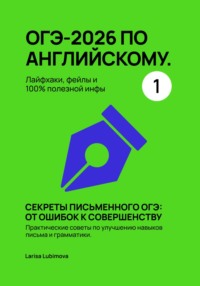
Полная версия
ОГЭ-2026 по английскому. Лайфхаки, фейлы и 100% полезной инфы. Часть 2
Student Tim raised his hand. «Sir, is this PROject about the proJECTor r? Because it’s still broken – »
«No! This PROject is about OBjects!» Higgins snapped, pointing to a stapler. «But if you obJECT, Tim, you can reCOrd your complaints on this REcord player!»
The chaos escalated. During recess, rebel student Zoe declared, «I’ll reBEL if he makes us memorize DEsert vs. deSERT! Who conTRACTS a CONtract for homework?!»
Meanwhile, the principal stormed in: «Higgins! The school PERmit expired! You can’t perMIT this noise!»
By day’s end, Higgins reCOrded a REcord-fast apology. Moral: If you proJECT confidence, maybe no one will notice your CONduct.
1.1.4 ТЕХНИКИ ЧТЕНИЯ
Представьте, что английский текст – это не просто набор слов, а живая мелодия. Можно монотонно бубнить ноты, а можно сыграть симфонию – с паузами, взлетами и эмоциями. Вот зачем нужны эти техники:
1. Вы прокачаете «английскую интуицию».
Техники вроде пауз-акцентов или ритмичного чтения учат вас чувствовать язык, как музыкант чувствует ритм. Со временем вы начнете предугадывать структуру предложений и даже… мыслить на английском.
Сравните:
– Робот: «I. Go. To. The. Shop.»
– Человек: «I’m gonna grab some snacks, wanna join?»
2. Вы перестанете бояться говорить.
Страх «неправильного акцента» или «глупого произношения» растворяется, когда вы неделю читаете тексты голосом драматичного кота или пирата. Голоса персонажей и интонационный микс – это тренажёр для вашей уверенности.
Плюс: Если вы можете прочитать меню так, что официант прыснет от смеха – вы готовы к small talk с кем угодно.
3. Вы сэкономите время.
Темповый контраст (быстро → медленно) учит вас схватывать суть на скорости и вникать в детали, когда нужно. Это навык, который пригодится:
В аэропорту: быстро прочитать объявление о переносе рейса.
На экзамене: чётко произносить слова, правильно расставлять интонационные акценты и уверенно передавать смысл текста, что создает положительное впечатление на экзаменатора.
В путешествии: моментально найти в меню «spicy», если вы не любите острое.
4. Вы сделаете английский частью жизни, а не «уроком».
Когда вы читаете рекламные слоганы, поёте песни или озвучиваете мемы – язык становится инструментом для радости, а не списком правил.
И самое главное:
Каждая из этих техник – как суперсила, которая остаётся с вами навсегда. Вы не просто «учите английский» для того, чтобы сдать экзамен. Вы учитесь слышать мир по-новому:
Улавливать юмор в сериалах без субтитров.
Понимать, почему все смеются над шуткой, которую вы раньше пропускали.
Чувствовать, как меняется смысл фразы от паузы или ударения.
Так зачем этим заниматься?
Потому что язык – это не экзамен, который нужно сдать. Это мост к другим людям, культурам и возможностям. И эти техники – ваши кирпичики для его постройки.
Начните с 5 минут в день. Прочитайте прогноз погоды с паузами, как диктор BBC. Проговорите список покупок голосом Джеймса Бонда. Устройте рэп-баттл с инструкцией от микроволновки.
Ваша цель – не идеал. Ваша цель – прогресс. А когда учишься с улыбкой, прогресс приходит сам.
P.S. Помните: даже Шекспир когда-то коверкал слова. Но он не перестал играть с языком – и стал легендой. Ваша очередь!
Техника 1. Интонационный микс
Задача: Менять интонацию в рамках одного текста (радость, грусть, сарказм, удивление).
Текст 1:
«The party was supposed to be epic. I spent hours decorating, baking a cake, and even learning magic tricks. But when the doorbell rang… it was just Mr. Jenkins, my 80-year-old neighbor. „Surprise!“ he yelled, holding a jar of pickles. „I brought snacks!“ The cat looked at me, as if saying: „This is your epic party?“»
Как тренировать:
Радостно: «The party was supposed to be EPIC!!!» (как ребёнок на день рождения).
Саркастично: «„Surprise!“ he yelled… (пауза) …holding a jar of pickles. Wow.»
Удивлённо: «The cat looked at me… (шёпот) AS IF SAYING: „This is your epic party?!“»
Текст 2:
«The hiking trip began with enthusiasm. „We’ll reach the peak by noon!“ said Tom confidently. Three hours later, we were lost, covered in mud, and arguing about which way was north. A goat stared at us from a cliff, chewing grass lazily. „Maybe the goat knows the way,“ I suggested. Tom sighed: „We’re taking advice from a goat now?“»
Техника 2. Темповый контраст
Задача: Чередовать быстрый и медленный темп.
Текст 1:
«Monday mornings are chaos. Alarm clock snoozed? Check. Toothpaste on shirt? Check. Missed the bus? Check. Running to work, I realized my shoes didn’t match. „At least my coffee is hot,“ I thought. Then… I tripped. The coffee flew. A pigeon landed nearby, tilting its head. „Really?“ it seemed to ask. „Really,“ I replied.»
Как тренировать:
Быстро: «Alarm clock snoozed? Check. Toothpaste on shirt? Check. Missed the bus? Check!»
Медленно: «Then… I… tripped. The coffee… flew. A pigeon… landed… nearby.»
Финал: «„Really?“ it seemed to ask. „Really,“ I replied.» (с паузой и разочарованием).
Текст 2:
«The bakery’s «World’s Best Croissants’ sign caught my eye. I entered, mouth watering. But as I reached for the last croissant… a hand grabbed it. «Mine,» said a woman in a business suit. «But…» I stammered. She shrugged: «Survival of the fittest.» The cashier whispered: «We have muffins.»»
Техника 3. Паузы-акценты
Задача: Делать паузы, чтобы выделить ключевые слова.
Текст 1:
«The old library was silent… until the book fell. Dust floated in the sunlight… revealing a hidden note. „Find the key… under the raven’s shadow,“ it said. I glanced at the stained-glass window… where a raven’s beak pointed… to the librarian’s desk. „Seriously?“ I muttered. Mrs. Wilkins smiled: „Overdue books first.“»
Как тренировать:
«The old library was silent… (пауза) until the book FELL.»
«„Find the key… (пауза) under the raven’s shadow.“»
«Mrs. Wilkins smiled… (пауза) „Overdue books first.“»
Текст 2:
«The magic lamp was dusty… but I rubbed it anyway. Poof! A grumpy genie appeared. „Three wishes. Make it quick,“ he said. I paused… „Can I wish for unlimited wishes?“ He groaned… „Classic. Denied.“ Fine. „I’ll take… a pizza,“ I said. The genie facepalmed… „You’re the worst.“»
Техника 4. Ритмичное чтение
Задача: Читать, отбивая ритм (как рэп, стихи или песню).
Текст 1:
I tried to bake a cake last night,
But something went absurdly wrong.
The flour flew, the eggs took flight,
The mixer sang a chaotic song.
The smoke alarm yelled, «Stop, you fool!»
The cat just laughed and said, «You’re cool.»
Как тренировать:
Читайте под метроном или отбивайте такт ногой:
«I TRIED to BAKE a CAKE last NIGHT,
But SOME-thing WENT absurdly WRONG…»
Текст 2:
The zombie walked into the bar,
«A brain martini, on the rocks!»
The bartender said, «Here you are,»
Then screamed, «Wait, you’re a ZOMBIE?!»
The zombie sighed, «No tips tonight…
They always freak out at first sight.»
1.1.5 ТРЕНИРОВОЧНЫЕ ЗАДАНИЯ
Текст 1
The concept of smart cities has evolved from a futuristic vision to a global reality, with AI-driven infrastructure managing everything from traffic flow to energy consumption. In Singapore (sɪŋə’pɔ: r), sensors embedded in streetlights adjust brightness based on pedestrian activity, while autonomous drones monitor air quality in real time. However, critics argue that such systems create a surveillance dystopia. For instance, facial recognition cameras in London have sparked protests, with activists labeling them a «violation of privacy» disguised as «public safety».
A 2025 report by Amnesty International revealed that data collected from smart meters and GPS trackers in Moscow and Beijing (beɪ’dʒɪŋ) is often sold to third-party advertisers without consent. Meanwhile, cybersecurity experts warn that hackers could exploit vulnerabilities in IoT devices to cripple power grids or transport networks. Proponents counter that transparency regulations and encryption (ɪn’krɪpʃən) technologies can mitigate risks, citing Amsterdam as a model where citizens vote on AI ethics policies via blockchain platforms.
Ключевые ловушки:
Infrastructure («ɪnfrəstrʌkʧə)
Autonomous (ɔ:'tɒnəməs)
Vulnerabilities (vʌlnərə’bɪlətiz)
Encryption (ɪn'krɪpʃən)
Ethics ('ɛθɪks)
Текст 2
By 2040, over 200 million people could be displaced due to rising sea levels, desertification, and extreme weather events – a phenomenon dubbed «climate migration». In Bangladesh), where monsoon floods submerge 20% of the land annually, farmers are relocating to Dhaka ('dɑ:kə), creating mega-slums with no access to clean water. Similarly, Pacific Island nations like Tuvalu (tu:'vɑ:lu:) face existential threats, as their highest points sit just 4 meters above sea level.
Western countries are not immune. In Arizona (ærɪ’zoʊnə), prolonged droughts have turned Phoenix (’fi: nɪks) into a «heat island», with temperatures exceeding 50° C. The EU’s 2025 Climate Refugee Act aims to grant asylum to those displaced, but debates rage over quotas and integration programs. Dr. Anika Patel, a climatologist at MIT, warns: «This is not a future crisis – it’s happening now. Miami could be underwater by 2070, yet policy inertia persists.»
Ключевые ловушки:
Desertification (dɪzɜ: rtɪfɪ’keɪʃən)
Monsoon (mɒn'su:n)
Prolonged (prə'lɒŋd)
Asylum (ə'saɪləm)
Inertia (ɪ'nɜ:rʃə)
Текст 3
AI diagnostics now outperform human doctors in detecting cancers, neurological disorders, and rare diseases. For example, DeepMind’s AlphaMed analyzes MRI scans (ɛm’ɑ:r aɪ skænz) with 99.3% accuracy, compared to 92% for radiologists. In rural India, chatbot triage systems screen patients via WApp, reducing hospital overcrowding by 40%.
However, ethical dilemmas abound. Algorithmic bias in AI models trained on Western medical data often misdiagnoses skin conditions in darker-skinned patients. A 2025 scandal erupted when IBM Watson Healthrecommended chemotherapy (’ki: moʊθerəpi) to terminal patients in Nigeria (naɪ’dʒɪriə) despite palliative care being the only option. Meanwhile, surgeons warn that overreliance on robotic systems erodes manual skills – a trend dubbed «generation button-pushers».
Ключевые ловушки:
Neurological (nʊrə’lɒdʒɪkəl)
Algorithmic (ælɡə’rɪðmɪk)
Chemotherapy (ki: moʊ'θerəpi)
Palliative ('pæliətɪv)
Surgeons ('sɜ:rdʒənz)
Текст 4
The monarch butterfly, known for its epic migration from Canada to Mexico (’mɛksɪkoʊ), is facing unprecedented threats. Each autumn, millions of these orange-and-black insects travel over 4,000 kilometers to oyamel fir forests in Michoacán (mi: tʃoʊə’kɑ: n), where they cluster on trees to survive winter. However, climate change has disrupted their breeding cycles, causing a 90% population decline since the 1990s.
Deforestation in Mexico exacerbates the crisis. Illegal logging in the Monarch Butterfly Biosphere Reserve ('baɪoʊsfɪər rɪ'zɜ:rv) has destroyed microclimates crucial for their survival. Meanwhile, in the United States (ju:'naɪtɪd steɪts), the widespread use of herbicides ('hɜ:rbɪsaɪdz) like glyphosate ('ɡlɪfəseɪt) has eradicated milkweed – the sole food source for monarch caterpillars. Conservationists now employ drones to plant milkweed seeds along migration corridors, but success remains uncertain.
Dr. Elena Cruz, a lepidopterist (lɛpɪ’dɒptərɪst) at Cornell University, states: «Monarchs are bioindicators; their collapse signals broader ecosystem failure. If they vanish, so could pollinators essential for agriculture.» Public awareness campaigns, like «Save the Monarch» in Texas, urge gardeners to plant native flora, offering hope for this iconic species.
Ключевые ловушки:
Herbicides ('hɜ:rbɪsaɪdz)
Glyphosate ('ɡlɪfəseɪt)
Lepidoptera (lɛpɪ’dɒptərə)
Biosphere ('baɪoʊsfɪər)
Agriculture ('æɡrɪkʌlʧər)
Текст 5
Iceland (’aɪslənd), often called the «Land of Fire and Ice», sits atop the Mid-Atlantic Ridge, where tectonic plates diverge. This geological hotspot is home to 130 volcanoes, including Eyjafjallajökull (eɪjəfjætlə’jɜ: kʊtl), whose 2010 eruption paralyzed European air travel for weeks.
Volcanic activity here is both a threat and a resource. Geothermal energy (dʒi: oʊ'θɜ: rməl) powers 90% of Icelandic homes, while tourists flock to sites like Fagradalsfjall (’faɣratalsfjatl), which erupted in 2023 after 800 years of dormancy. However, glacial floods caused by eruptions, known as jökulhlaups (’jɜ: kʊlhlaʊps), can devastate infrastructure.
Dr. Sigurður Magnússon, a volcanologist (vɒl'keɪnələdʒɪst) at the University of Iceland, explains: «We’re constantly balancing risk and reward. Lava fields create fertile soil, but ash clouds threaten aviation.» The 2025 eruption of Katla, one of the most dangerous volcanoes, is now overdue, keeping residents and scientists on high alert.
Ключевые ловушки:
Eyjafjallajökull (eɪjəfjætlə' jɜ: kʊtl)
Geothermal (dʒi: oʊ'θɜ: rməl)
Jökulhlaup (' jɜ: kʊlhlaʊp)
Volcanologist (vɒl'keɪnələdʒɪst)
Katla ('khahtla)
Текст 6
Coral reefs, often dubbed the «rainforests of the sea», support 25% of marine life despite covering less than 1% of the ocean floor. The Great Barrier Reef off Australia has lost 50% of its coral since 1995 due to ocean acidification and bleaching caused by rising temperatures.
Restoration efforts are underway. In the Caribbean, scientists use 3D-printed coral structures to mimic natural reefs, attracting juvenile fish and crustaceans. Meanwhile, coral IVF – collecting spawn from healthy reefs and dispersing it in damaged areas – shows promise in Hawaii.
Dr. Maria Torres, a marine biologist (mə'ri:n baɪ'ɒlədʒɪst), warns: «Even if we curb emissions tomorrow, reefs need decades to recover. Overfishing and pollution must also stop.» Artificial reefs made from sunken ships or concrete offer temporary relief, but only global cooperation can prevent an ecological collapse.
Ключевые ловушки:
Acidification (əsɪdɪfɪ’keɪʃən)
Crustaceans (krʌ'steɪʃənz)
Overfishing (oʊvər’fɪʃɪŋ)
Emissions (ɪ'mɪʃənz)
Ecological (i: kə’lɒdʒɪkəl)
Текст 7
The Arctic wolf, a subspecies of the gray wolf, thrives in the harsh tundra of Greenland and Northern Canada. Unlike their southern relatives, these wolves have thicker fur, smaller ears, and white coats that provide camouflage ('kæməflɑ:ʒ) against the snow. They hunt musk oxen and Arctic hares, often traveling 100 kilometers a day in search of prey.
Climate change, however, is altering their habitat. Permafrost ('pɜ:rməfrɒst) thawing has disrupted migration routes of caribou ('kærɪbu:), their primary food source. Additionally, industrial activity in the Yamal Peninsula (jə'mɑ:l pə'nɪnsjʊlə) has led to habitat fragmentation, forcing packs into smaller territories. Dr. Lars Johansen, a wildlife biologist, notes: «Arctic wolves are keystone species. Their decline could trigger trophic cascades, destabilizing the entire Arctic ecosystem.»
Conservationists advocate for protected corridors and stricter oil drilling regulations. Meanwhile, Indigenous communities in Nunavut ('nʊnəvʊt) share ancestral knowledge to track wolf movements using drones and satellite collars.
Ключевые ловушки:
Camouflage ('kæməflɑ:ʒ)
Permafrost ('pɜ:rməfrɒst)
Caribou ('kærɪbu:)
Trophic ('troʊfɪk)
Nunavut ('nʊnəvʊt)
Текст 8
The Amazon River, stretching 6,400 kilometers through Brazil (brə’zɪl), Peru, and Colombia (kə’lʌmbiə), sustains the world’s largest tropical rainforest. Its biodiversity (baɪoʊdaɪ’vɜ: rsəti) is unparalleled: one hectare houses over 400 tree species, 1,300 butterfly species, and 3,000 fish species, including the piranha (pɪ’rɑ: nə).
Deforestation for soy plantations and cattle ranching has reduced the rainforest by 20% since 2000. Illegal logging in Pará (pɑ:’rɑ:) and Rondônia (ron’doʊniə) releases 500 million tons of CO₂ annually. Indigenous tribes like the Yanomami (jɑ: nə’mɑ: mi) resist invaders, but face violence from land grabbers.
Hydropower dams, such as Belo Monte ('bɛloʊ 'mɒnteɪ), disrupt fish migration and sediment flow, threatening aquatic life. Dr. Ana Silva, an ecologist, warns: «The Amazon is nearing a tipping point – if 25% is destroyed, it could transform into a savanna.» Global initiatives like REDD+ (Reducing Emissions from Deforestation and Forest Degradation) fund conservation, but corruption hampers progress.
Ключевые ловушки:
Biodiversity (baɪoʊdaɪ’vɜ: rsəti)
Piranha (pɪ'rɑ:nə)
Hydropower (’haɪdrəʊpaʊər)
Sediment ('sɛdɪmənt)
Savanna (sə'vænə)
Текст 9
In Japan (dʒə'pæn), where aging farmers outnumber the youth, agribots ('æɡrɪbɒts) are revolutionizing agriculture. These AI-powered robots plant rice, pick strawberries, and even prune grapevines with millimeter precision. The Tomato Harvesting Robot in Shizuoka (ʃi:zu:'oʊkɑ:) uses computer vision to detect ripeness, reducing labor costs by 70%.
Vertical farms in Singapore grow leafy greens under LED lights, using 95% less water than traditional methods. However, critics highlight energy consumption and e-waste from discarded robots. Dr. Kenji Nakamura, a roboticist, argues: «Agribots can’t replace traditional knowledge. A machine can’t sense soil health like a seasoned farmer.»
In California, autonomous tractors map fields via GPS, optimizing fertilizer use. Yet, rural communities fear job losses. «We need upskilling programs, not just machines,» says Maria Gomez, a farmworkers’ union leader.
Ключевые ловушки:
Agribots ('æɡrɪbɒts)
Computer vision (kəm'pju:tər 'vɪʒən)
Fertilizer ('fɜ:rtəlaɪzər)
Upskilling (ʌp'skɪlɪŋ)
Autonomous (ɔ:'tɒnəməs)
Текст 10
The Māori ('maʊri), Indigenous people of New Zealand, are revitalizing their language and traditions after centuries of colonial suppression. Haka ('hɑ:kə), a ceremonial dance popularized by the All Blacks rugby team, is now taught in schools to preserve cultural identity.









